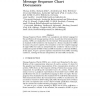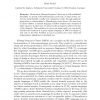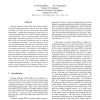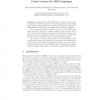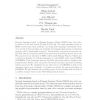117
click to vote
TOPNOC
2008
15 years 13 days ago
2008
Message Sequence Charts (MSCs) are a well known language for specifying scenarios that describe how different actors (e.g., system components, people, or organizations) interact. M...
108
Voted
CORR
2010
Springer
15 years 19 days ago
2010
Springer
Message Sequence Charts (MSCs) are an appealing visual formalism mainly used in the early stages of system design to capture the system requirements. However, if we move towards a...
104
Voted
FORTE
1998
15 years 1 months ago
1998
Message Sequence Charts (MSCs) are a graphical and textual language for the speci cation of message passing systems, in particular telecommunication systems. MSCs are standardised...
136
click to vote
TACAS
1998
Springer
15 years 4 months ago
1998
Springer
The latest ITU-T standard syntax of Message Sequence Charts (MSCs) 16] o ers several operators to compose MSCs in a hierarchical, iterating, and nondeterministic way. However, curr...
142
click to vote
FOSSACS
2001
Springer
15 years 5 months ago
2001
Springer
Hierarchical Message Sequence Charts are a well-established formalism to specify telecommunication protocols. In this model, numerous undecidability results were obtained recently ...
103
Voted
ACSD
2003
IEEE
15 years 5 months ago
2003
IEEE
Message Sequence Charts (MSC) have been traditionally used to depict execution scenarios in the early stages of design cycle. MSCs portray inter-process ( inter-object) interactio...
113
click to vote
FSTTCS
2005
Springer
15 years 6 months ago
2005
Springer
Abstract. Message sequence charts (MSCs) are commonly used to specify interactions between agents in communicating systems. Their visual nature makes them attractive for describing...
101
click to vote
ASWEC
2005
IEEE
15 years 6 months ago
2005
IEEE
Message Sequence Charts (MSCs) are a graphical language for scenarios of communicating components exchanging messages in a distributed environment. The language has been standardi...
120
click to vote
CONCUR
2007
Springer
15 years 6 months ago
2007
Springer
Scenario languages based on Message Sequence Charts (MSCs) have been widely studied in the last decade [21,20,3,15,12,19,14]. The high expressive power of MSCs renders many basic ...
105
click to vote
SEFM
2009
IEEE
15 years 7 months ago
2009
IEEE
Abstract. We introduce a visual notation for local specification of concurrent components based on message sequence charts (MSCs). Each component is a finite-state machine whose ...

